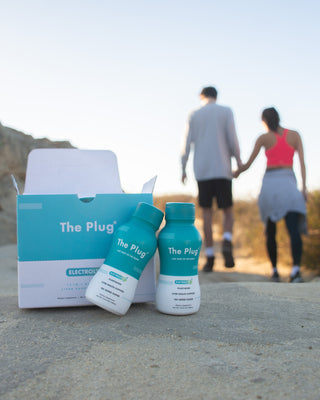active lifestyle
Hiking for Joint Health: A Natural Path to Stronger, More Flexible Joints
The Plug Drink

The Plug Team

Summer is here, PlugFAM! That means it’s the perfect time to indulge in your favorite outdoor activities. And if hiking isn’t currently one of them, let us help you change that!
Hiking is more than just a pleasant outdoor activity — it's a powerful tool for maintaining and improving joint health. This low-impact exercise offers numerous benefits for people of all ages, from strengthening muscles to promoting cartilage health. Today, let's explore how hitting the trails can lead to healthier, more flexible joints!
Low Impact, High Reward
Hiking is classified as a low-impact exercise, meaning it puts less stress on joints compared to high-impact activities like running or jumping (1). This makes it an excellent option for people looking to improve their fitness without risking joint damage! Unlike activities that involve repetitive impacts on hard surfaces, hiking allows for natural movement patterns on varied terrain, which can be gentler on the joints.

Benefits of Joint Health
The advantages of hiking for joint health are numerous, but let us share our top four favorites:
1. Muscle Strengthening: Hiking engages multiple muscle groups, particularly in the legs and core. Stronger muscles provide better support for joints, reducing the risk of injury and improving overall joint function (2).
2. Improved Flexibility: The varied movements required during hiking, such as stepping over rocks or navigating uneven terrain, can increase flexibility and range of motion in joints (3).
3. Cartilage Health: Regular movement, as provided by hiking, helps nourish cartilage by promoting the flow of synovial fluid in the joints (4).
4. Weight Management: Hiking is an effective calorie-burning activity. Maintaining a healthy weight reduces stress on weight-bearing joints like knees and hips (5).
Hiking for All Ages
One of the great aspects of hiking is its adaptability for different age groups and fitness levels! Children can develop strong bones and joints through regular hiking, while adults can maintain joint health and flexibility. For seniors, gentle hikes can help preserve mobility and reduce the risk of falls (6). Moreover, being outside in the sun while hiking is beneficial for joints because it allows the body to absorb vitamin D, which can help decrease inflammation. This natural vitamin D synthesis contributes to overall joint health and can complement the physical benefits of hiking. Be sure to wear your sunscreen though!

4 Tips for Joint-Friendly Hiking
To maximize the benefits and minimize risks of hiking, please:
1. Wear proper footwear with good support and cushioning.
2. Use trekking poles to reduce impact on knees and improve balance.
3. Start with easier trails and gradually increase difficulty and duration.
4. Always warm up and stretch before hiking and cool down afterwards. Make sure to include stretching before and after the hike!
Recovery and Hydration
Post-hike recovery is crucial for joint health. To recover the right way, follow our top three tips:
1. Stretch It All Out: Gentle stretching prevents stiffness.
2. Utilize Passive & Active Recovery: Passive (static holds) improves flexibility; active (light movement) enhances blood flow.
3. Always Rehydrate: Proper hydration maintains joint lubrication, so be sure to drink before, during, and after hiking. This is where electrolyte replenishment becomes super important! Luckily, The Plug Drink is the perfect solution for hikers looking to replenish essential minerals lost through sweat. With our refreshing 13-in-1 blend and the powerful addition of electrolytes, we got you covered! Proper electrolyte balance is crucial for muscle function and can aid in reducing joint inflammation after a hike (7).

Precautions & Considerations
While hiking is generally safe, it's important to consult with a healthcare provider before starting any new exercise regimen, especially if you have pre-existing joint conditions. Always listen to your body and know when to rest or seek medical attention if you experience unusual pain or discomfort!
Hike Your Way to Success
Hiking offers a natural, enjoyable way to improve joint health. By incorporating regular hikes into your lifestyle, you can strengthen muscles, improve flexibility, and promote overall joint health. Quite a triple threat, right? Remember to start slowly, stay hydrated, and enjoy the journey to healthier joints. Happy trails and best of luck on your hiking adventures, PlugFAM — may they lead you to stronger joints and unforgettable experiences in nature!
Bibliography
1. 5 Low-Impact Exercises to Alleviate Joint Pain [Internet]. University of Maryland Medical System | University of Maryland School Medicine. Available from: https://health.umms.org/2020/12/12/low-impact-exercises-for-joint-pain/
2. Vieira MF, de Avelar IS, Silva MS, Soares V, Lobo da Costa PH. Effects of Four Days Hiking on Postural Control. Public Library of Science One [Internet]. 2015 Apr 22;10(4):e0123214. Available from: https://www.ncbi.nlm.nih.gov/pmc/articles/PMC4406731/
3. What Are the Benefits of Hiking? [Internet]. Colorado Wilderness Rides and Guides. 2023 June 5. Available from: https://coloradowildernessridesandguides.com/hiking/what-are-the-benefits-of-hiking/
4. Jeong J-N, Kim S-H, Park K-N. Relationship between objectively measured lifestyle factors and health factors in patients with knee osteoarthritis. Medicine (Baltimore) [Internet]. 2019 June 28;98(26):e16060. Available from: https://www.ncbi.nlm.nih.gov/pmc/articles/PMC6616066/
5. Blane DN, Macdonald S, O'Donnell CA. What works and why in the identification and referral of adults with comorbid obesity in primary care: A realist review. Obesity Reviews [Internet]. 2020 Apr;21(4):e12979. Available from: https://doi.org/10.1111/obr.12979
6. Mitten D, Overholt JR, Haynes FI, D’Amore CC, Ady JC. Hiking: A Low-Cost, Accessible Intervention to Promote Health Benefits. American Journal of Lifestyle Medicine [Internet]. 2016 July 9;12(4):302-310. Available from: https://www.ncbi.nlm.nih.gov/pmc/articles/PMC6993091/
7. Casa DJ, Armstrong LE, Hillman SK, Montain SJ, Rich BSE, Roberts WO, et al. National Athletic Trainers' Association Position Statement: Fluid Replacement for Athletes. Journal of Athletic Training [Internet]. 2000;35(2):212-224. Available from: https://www.ncbi.nlm.nih.gov/pmc/articles/PMC1323420/pdf/jathtrain00002-0094.pdf
